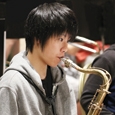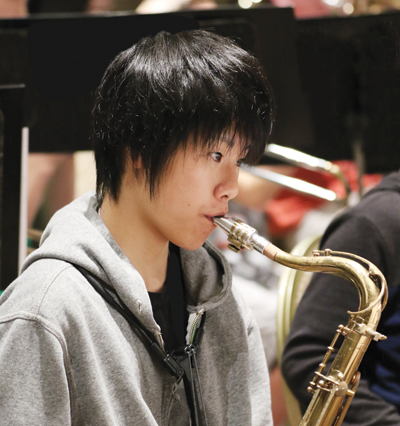
Improvisation is crucial to jazz performance, but style and sound provide the foundation on which everything else is built. Too often the daunting prospect of mastering improvisation leads young players to make it the focus of study. As a result, they either become too intimidated to pursue jazz, or they neglect the fundamentals of a jazz sound and basic stylistic concerns. However, once a performer has established a concept of tone and appropriate stylistic practices, improvisation can fall into place much more easily.
Listening to the Language
Music is a language. Certainly, jazz is a very specific – but always developing – language. It has rules of grammar and pronunciation, as well as dialects from Dixieland to Bebop to Fusion. As discussed by jazz pedagogue Mike Steinel, “the easiest way to master any language is to learn it conversationally. As we learn to converse with others we not only expand our vocabulary, but we also gain an intuitive understanding of proper pronunciation and grammar.” A saxophonist cannot perform out of a jazz etude book and learn the correct dialect or pronunciation of the language through the notation alone. It is essential to hear fluent performers and then imitate them, one word or phrase at a time. By listening to Charlie Parker, the solos in the Omnibook instantaneously gain greater clarity. When performing a solo from the book, saxophonists should strive to copy every aspect of Parker’s playing, including his tone, inflections, vibrato, and articulation.
Tone: Embouchure
In The Art of Saxophone Playing, Larry Teal goes to great lengths to describe a classical saxophone embou-chure, including photos showing correct and incorrect examples. One of Teal’s incorrect examples shows a bunched chin, with the caption, “chin muscles bunched.” However, a bunched chin can be seen in pictures of almost every jazz saxophonist, and it is one of the correct approaches to jazz embouchure formation.
Students should experiment with this to hear if the resulting tone is desirable. The chin itself does not control tone; it is a signifier of how the lower lip is making contact with the reed. A bunched chin will cause the lower lip to roll slightly forward. This provides a fatter lip with more cushion for the teeth, allowing for flexibility to move the jaw. Saxophonist Steve Duke describes what he calls a “flat lip” embouchure as “basically the same as a classical embouchure, except that the jaw drops down, the bottom lip rolls out slightly, and the chin is bunched and drawn upward toward to the reed. The lip is more mushy and has more surface contact with the reed than in classical saxophone embouchure.” The larger surface area of the lip against the reed outside of the mouth slightly restricts reed vibration. This brings more subtone to the sound, which is usually desirable in a jazz setting. This can be checked during practice either by feel (with a finger) or by sight (using a mirror).
A variation on this approach was taught to a number of jazz masters by pedagogue Joe Allard. This approach to embouchure also requires flexibility of the lower jaw, but David Liebman, one of Allard’s pupils, states that the position of the lip on to the reed should change based on register. For low notes, “less of the reed tip vibrates as the bottom lip moves towards the tip of the reed.” For upper register notes, “more of the reed tip vibrates as the bottom lip rolls away from the tip of the reed.” In other words, a fatter lip is used as a cushion for the jaw to move towards and away from the tip of the reed. Although approaches to a jazz embouchure can vary quite a bit, it is universally agreed that the lower jaw is much more flexible and engaged than that of the classical embouchure.
Tone: Airstream
Airstream is arguably the most crucial difference between classical and jazz performance. In classical performance, saxophonists generally strive for a high degree of “air stream artistry,” to use a phrase coined by Jim Riggs. This refers to tapered staccatos, crescendos and diminuendos, and accents, all of which are mastered by controlling and managing changes in the airstream.
In jazz performance, however, the airstream is generally constant. An effective analogy is a garden hose attached to a faucet. When the water faucet is turned on, the water source will be continuous and consistent. The flow and pressure of the water can still be manipulated and controlled, but this happens at the end of the hose rather than at the faucet. While playing a phrase in jazz, the air will be continuous, just like the water source, and should not be turned off until the phrase is finished.
To encourage a full and supported airstream, stuff a medium-sized towel into the bell of the saxophone to create resistance. The towel will completely block the lowest tone holes, so it will likely be impossible to play below a low D. With the towel in the bell, the performer should play a chromatic scale from middle D to low D, as loudly as possible; despite the resistance of the towel, a fortissimo dynamic should be the goal for every note. Then, remove the towel and play the same scale using the same airstream. With the resistance of the towel removed, the instrument should feel more free-blowing and the tone fuller and louder. This simple exercise generally produces immediate results.
Tone: Pitch Center
The primary reason younger jazz saxophonists often have a thin sound is that they do not move enough air through the instrument. The above exercise provides the first step; however, a jazz tone will be possible only once the performer has lowered their pitch center. This is a result of a focused, more-supported airstream, and a manipulation of the oral cavity. A simplified method of lowering pitch center is to push in the mouthpiece, drop the jaw, push a large amount of air through the mouthpiece, and play in tune, despite the mouthpiece being pushed in.
Although Eugene Rousseau recommends a mouthpiece pitch of concert A5 for an alto saxophonist playing classical music with an appropriate airstream, when performing jazz, my mouthpiece pitch on alto saxophone is as much as a perfect fourth lower. In her dissertation comparing mouthpiece pitch in jazz and classical performance, Vanessa Hasbrook suggested an Eb as the mouthpiece pitch that creates a jazz tone, and others use a mouthpiece pitch closer to G, so there is no consensus on which should be considered correct, beyond that all of the mouthpiece pitches are lower than the A recommended for classical saxophonists. Suggested mouthpiece pitches for jazz saxophone performances are alto: between G and Eb, tenor: between E and Db, and baritone: between D and C.
Voicing, an awareness and control of the muscles and soft flexible tissue in the oral cavity and vocal tract, is crucial when working on such performance aspects as mouthpiece pitch, overtones, and altissimo. Changes to the oral cavity can be as simple as moving the tongue around while sustaining a note. Additional exercises to are discussed by Donald Sinta and Denise Dabney in Voicing. One of these exercises, taught by a number of saxophonists such as Noah Getz, is to speak the long vowel sounds in the English alphabet (a, e, i, o, and u). When doing so, one notices a change in tongue position, with u (as in new) being lowest in the mouth and e (as in we) the highest. When saxophonists say “drop the jaw to lower the pitch,” what is really meant is a change in the oral cavity; generally instigated by a lowering of the front of the tongue in the mouth.
The next step is to lower the pitch center gradually by playing the following exercises on the mouthpiece alone. Every day or two, try to begin a half-step lower than the previous day, until an E – or whichever pitch is the goal – is reached. It is important to be patient and realize that this may take several weeks to accomplish.
Mouthpiece Pitch Exercise
(for alto saxophone)
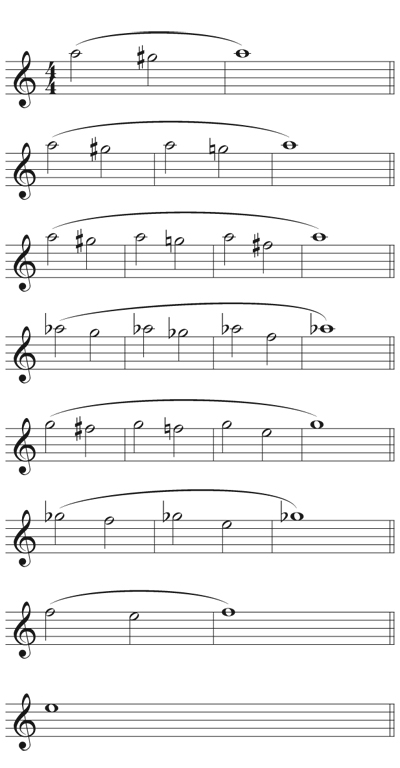
Even after students can consistently produce a lowered mouthpiece pitch, it still should be monitored occasionally throughout practice sessions. Remove the mouthpiece and play on it with the airstream and embouchure used during practice. Pitch can be checked with a piano or tuner. There may be a difficult transition initially, but it is recommended at this point to push in the mouthpiece and practice with a tuner. Play in tune by dropping the jaw and moving more air. It is important to keep the airstream constant.
Tone is a personal and distinctive aspect of jazz saxophone performance. Many great performers can often be identified solely by their sound. Although a wide range of tones exists among saxophonists, a common thread among top jazz artists is consistency; their tone is consistent across all registers of the horn. It is therefore crucial to practice full-range scales and arpeggios while maintaining a consistent sound across all registers.
Style: Vibrato
Bridging both tone and style concepts is vibrato. In both classical and jazz performance, trends in vibrato usage have changed over time, speed and depth of vibrato can vary from one piece to the next, and no two performers use it exactly the same way. Because of this, it is difficult to make sweeping statements regarding vibrato. Generally speaking, however, today’s jazz saxophonists tend to use narrower vibrato than earlier saxophonists, such as Marshall Royal or Coleman Hawkins, and they use it less frequently. Sonny Rollins, for example, is often extremely selective in his application of vibrato. A phrase consisting of several sustained notes might include a single note embellished with a constant traditional vibrato, while the rest are performed with a straight tone. In his performance of The Surrey with the Fringe on Top he uses vibrato only twice in sixteen measures.
For many saxophonists who are new to jazz, there is a tendency to use too much vibrato. It is best for students to eliminate vibrato until tone and articulation are consistently being performed in a satisfying way.
Terminal vibrato is common in jazz. This term refers to vibrato that ends, or terminates, a note. This can be heard in the playing of saxophonists as diverse as Sonny Rollins, Art Pepper, Cannonball Adderley, and Jon Gordon. Notes with terminal vibrato appear at all tempos, from ballads to up-tempo bebop. To incorporate terminal vibrato into jazz performance, it is first recommended to practice the technique on single notes. Play a whole note at quarter note = 100 with a straight tone for three beats. End the note with an exaggerated shake of the lower jaw to get two or three undulations during beat four, before the release. It is important to maintain a consistent airstream until the note is released. At first, it is acceptable to exaggerate to the point of shaking the lower jaw off of the mouthpiece. This may feel quite awkward initially. Ultimately, however, the jaw can be pulled backwards at the moment of the note’s release to muffle the reed vibration and stop the note. Once a convincing terminal vibrato can be produced on a single note, apply it to sustained notes in the melodies of jazz standards. Students should also transcribe and emulate jazz saxophonists playing these tunes, which often consist of longer note values and provide good examples of terminal vibrato. Once mastered in these practice situations, the technique will begin to feel natural and can be used within improvised solos. It is important to keep in mind that this is a method of ending a note, rather than a typical expressive vibrato.
Young players are encouraged to listen and emulate their favorite saxophonists. After adopting the styles of several players, a student’s voice will emerge.
Style: Offbeat Articulation
Articulation has been examined in-depth by a wide range of saxophonists, including Joe Allard, George Garzone, Jean-Marie Londeix, Larry Teal, and Scott Zimmer. In 2002, Zimmer used fiber optics to study the articulation of jazz and classical saxophonists. Among other discoveries, Zimmer found that there are essentially two different approaches to saxophone articulation: “The exploratory study suggests that, generally, more tongue surface area touches the reed in jazz articulation than in orchestral articulation. Also, the entire tongue appears to move in jazz articulation, while the tip moves somewhat more independently of the middle and back of the tongue in orchestral articulation.”
In jazz performance, articulation may appear to have undefined rules, due to the improvisatory nature of the genre. Additionally, notation is inconsistent in jazz. For example, an eighth-note phrase may be written in a highly notated fashion with slur and articulation markings, have no articulations at all, or use a slur marking to indicate a phrase. Performers can, however, apply a few clear concepts in order to interpret these varying approaches to notation.
First, regardless of the notational style, the default interpretation for playing eighth notes in jazz should be to use an offbeat articulation. As seen in the example below, this means the offbeats will be articulated and then slurred into the following downbeat. The sound should be continuous and unaccented. In swung jazz, eighth-notes should always be legato and connected, unless otherwise indicated. As always, a consistent airstream is important. Play a scale to the ninth with swinging eighth-notes, and articulate the offbeats.
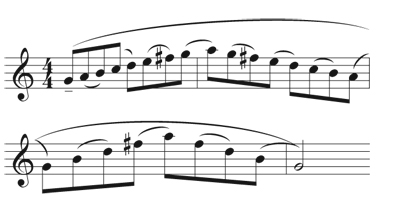
To avoid articulating the first two notes in a row, the exercise can be altered simply by adding a leading-tone pickup. This can be seen in the following example and may provide a more desirable starting point, since the phrase begins with the offbeat articulation. Again, strive for a connected sound and legato articulation. A constant airstream will avoid the phrase sounding too bouncy. This is a good rule for a standard articulation in swung music.
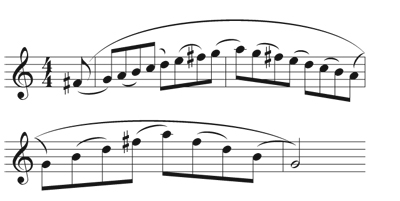
When applying this rule to a jazz etude, and ultimately to improvisation, longer phrases may become too predictable. Once comfortable with articulating every offbeat, begin to vary articulations by sometimes articulating every fourth note. This approach of articulating less frequently typically sounds more effective on descending passages. Ascending scales and changes of direction within a melodic line often require more frequent articulation. Generally, articulations can also be added following a large leap. After mastering offbeat articulation, performers should trust their ear and good musical instinct to determine whether longer slurs should be added into a phrase to smooth it out.
Style: Marcato Accents
Another articulation to address is the marcato, or housetop, accent. The marcato is rarely indicated in notated music, therefore the performer is expected to know when it is appropriate. This type of accent is often used on eighth notes preceding a rest as well as quarter notes, which are by default staccato or marcato.
Marcato notes (whether notated as quarter or eighth notes) should be performed as fat, full-bodied notes stopped by the tongue on the reed. The daaht syllable is good for expressing the articulation (d), a full-bodied note (aah), and finally the tongue closing off the reed (t). The air pressure must remain constant, which can be elusive for a classical performer more accustomed to tapering releases. It is crucial to remember that the tongue stops the sound, rather than the airstream. Returning to the water hose analogy, this would be the equivalent of a hand covering the end of the hose, blocking all water from escaping. The faucet remains on, and the water source is constant. On saxophone, the air has nowhere to go, as the sound is stopped by the tongue against the reed. Therefore, the saxophonist should feel the air pressure against the tongue and reed until either the air is stopped after the t of daaht has finished or the tongue is released to attack another note.

If the marcato note is followed by another note, then the release of the tongue will serve as the articulation for the next note. A famous example of this can be found in the opening phrase of In The Mood. The silence between the repeated notes is a result of the tongue stopping the reed vibration while the airstream remains constant. The tongue’s movement off of the reed provides the articulation for the following note. Practice this at various tempos. As in classical performance, the length of the note gets shorter as the tempo increases. At slower tempos, notes with a marcato will have quite a bit of body, while faster speeds will necessitate shorter marcato notes.
As Written:

Suggested Interpretation:
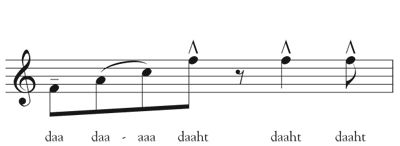
Style: Ghost Notes
When the tongue stops the airstream, it creates the sharp cutoff required for marcato notes, as discussed above. The tongue can also limit the amount of air that gets into the mouthpiece. Accents and ghost notes often go hand-in-hand in jazz performance, partially because of a motion of the tongue on and off the reed.
A ghosted, or quieter, note is not produced by a reduction of air. Rather, a portion of the tongue touches about half of the reed in order to dampen the sound. A by-product of this is that ghost notes generally go sharp; however, this is nothing to be concerned about. To create a ghost note, this author articulates further back from the tip of the tongue than a standard articulation, approximately 3⁄4" from the tip. This part of the tongue touches almost half of the tip of the reed, which muffles the vibration. Completely covering the reed is not desirable for ghost notes, as it will completely stop the sound. Alternatively, ghosting too lightly with the tongue will cause a ticklish vibration. A full airstream must be maintained while the tongue firmly touches the reed. In the example below, daaa represents an articulated note with a full tone, and nnn represents a ghosted note. Like repeated marcato accents, the articulation following a ghost note results from the tongue’s motion off of the reed. It is not a re-articulation, but a release from the ghosted note. In other words, the release of the tongue will then become the articulation for the next note. A slight accent is produced when the reed is able to once again vibrate freely. If there is no accent, it may be an indicator that the airstream has been reduced.

After it becomes comfortable to ghost single pitches, the technique should be practiced on a melody with a repeated melodic pattern, such as Night Train, in which every downbeat is treated with a ghost note. If the technique is applied correctly, the accents and ghost notes will be greatly exaggerated.
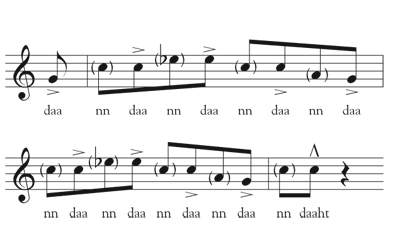
Style: Jaw Accents
When observing jazz saxophonists, one immediately notices jaw movement, which is almost never a part of classical saxophone performance technique. It may appear as if the performer is chewing on his mouthpiece. In reality, this is a method of creating accents. Put simply, the jaw can either move backward in order to muffle the reed vibrations or forward to free up the reed vibrations, which creates an accent. Play the two above examples, creating accents only by moving the jaw and without articulating. The jaw should jut forward on the offbeats to create an underbite, and pull backwards on the downbeats quickly to create an overbite. This may feel and sound less natural than the ghost note articulation. Play Night Train again, but articulate the offbeats in addition to the jaw accents. As always, maintain a steady airstream.
This technique can be used on its own or in conjunction with a ghost note articulation. The two techniques should be practiced both separately and simultaneously. When using the tongue to ghost a note, it can be combined with a backwards jaw movement. Likewise, the forward jaw motion can coincide with the tongue’s release to create even more of an accent on the following note. The accents will be greatly exaggerated in the exercises; however, in an actual playing situation, these elements should be applied more subtly. A combination of these techniques can result in quite a variety of possible articulations and accents. Recordings of Cannonball Adderley provide innumerable examples of virtuosic and varied jazz articulations.
Applying The Techniques
These techniques may feel foreign when first encountered, and a student may not believe that such approaches to articulations and accents are feasible in actual performance situations. However, after careful practice of a handful of jazz etudes, they will begin to feel natural. First, isolate short phrases from a jazz etude and write in exactly which notes should be ghosted, accented, or slurred. Then, move on to longer phrases, repeating the phrases slowly and ensuring that a constant airstream is maintained while accents are created with the jaw and tongue. Be rigorous and consistent; the belief that jazz music is less precise than classical music can be a hindrance when learning these techniques. Below are two short phrases similar to those found in a jazz etude, a transcription, or a big band chart. These two phrases demonstrate all of the stylistic techniques that have been discussed.
Offbeat articulation, ghost note, accent, and marcato. As written:

Suggested interpretation:

Slurs, offbeat articulation, repeated marcato, and jaw accent. As written:
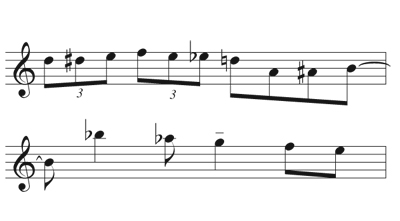
Suggested interpretation:
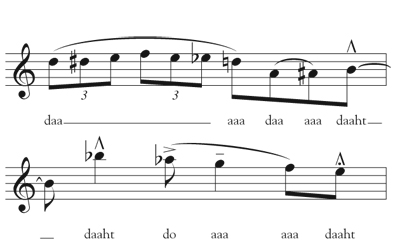
Below is a stylistic analysis of one chorus from Cannonball Adderley’s recording of Barefoot Sunday Blues (beginning at 0:41), showing how stylistic elements are used in performance. It is impossible to know Adderley’s exact tongue and jaw movements during the performance; however, based on those techniques discussed above, a best guess regarding his jaw position is shown in italics below each staff. The forward jaw position allows the reed to vibrate freely, resulting in a louder and more open sound. The back position creates a softer sound with more subtone. The ghost notes (measures 3, 5, 9, 10) are created with a combination of a back jaw position with the tongue on the reed (an nn syllable). Notes following the ghosted ones are accented as a result of the tongue release and forward jaw movement. Measure 6 indicates a gradual movement of the jaw, as opposed to the sharp movements forward and back that are otherwise used. This essentially creates a crescendo across the ascending arpeggio and a slight diminuendo on the descending triplets. As always, Adderley demonstrates a consistent and supported airstream. The changes in dynamic predominantly result from jaw movement and ghost-tonguing. A consistent vibrato is used twice in this example (measures 2 and 11), with an exaggerated depth in measure 11. Adderley does not employ terminal vibrato in this example, although it was certainly an element of his style on numerous recordings. Adderley always performed with a variety of articulations, and these are evident in this excerpt. A few suggested syllables are written in, including the housetop accent in measure 4. Measure 10 contains the only phrase in which he uses the traditional offbeat articulation. 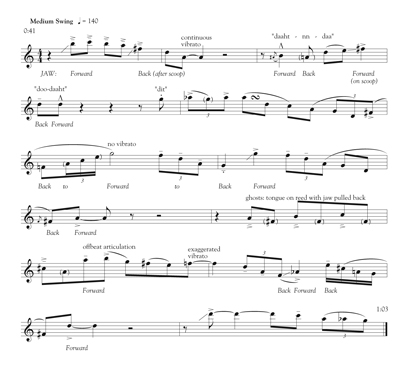
Conclusion
While improvisation is crucial to jazz performance, the building blocks are a personal and consistent tone and an attention to style. An analysis of just one chorus from a single saxophonist highlights the necessity of mastering techniques specific to jazz. A classical approach to air, articulation, accenting, and vibrato will yield different results than those achieved by Cannonball Adderley. Transcription and etude books often include only a few notated articulations; it is up to students of jazz to listen and emulate articulations, accents, tone, and vibrato. These elements are a part of the jazz vernacular and can be mastered through careful practice and repetition.
Resources
There are a number of excellent jazz etude books available. A few suggested books are listed below, in order of difficulty. All of these books come with CDs that demonstrate one interpretation. Embrace the individuality of jazz and remember that other interpretations are allowed, as long as they are performed consistently and with confidence.
Basic Jazz Conception for Sax-ophone, Vol. 1 by Lennie Nie-haus (Try Publishing). This is an excellent book for beginners, with all articulations written in.
Jazz Conception by Jim Snidero (Advance Music). More challenging than Niehaus, etudes are based on the chord progressions of jazz standards. Some articulations are written in.
Jazz Saxophone Etudes, Vol-ume 2 by Greg Fishman (Greg Fishman Jazz Studios). With excellent etudes in multiple volumes, this collection is idiomatic and challenging. Few articulations are written in.
14 Blues & Funk Etudes and 12 Contemporary Jazz Etudes by Bob Mintzer (Warner Bros.). Etudes move beyond standard swing and bebop phrasing and require greater variety of articulation.
